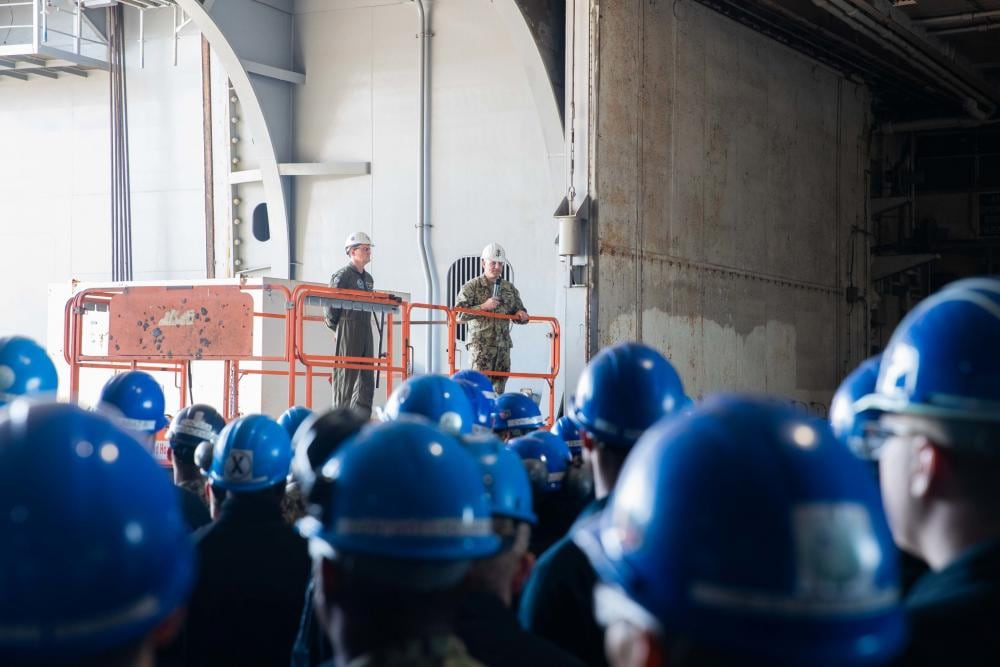Headlines over the past several months have highlighted the U.S. Navy’s challenge of suicide within its ranks.
An alarming sign of the problem was when three junior sailors assigned to the aircraft carrier George Washington completed suicide within a six-day period in April 2022. Then, late last year, four sailors took their lives at the Mid-Atlantic Regional Maintenance Center in Norfolk, Virginia. Most recently it came to light that five sailors and instructors assigned to the Navy’s Nuclear Power School in Charleston, South Carolina died by suicide since 2018 with another 24 suicide attempts within the same timeframe. Reading between the lines, it’s clear that the Navy is struggling with traditional “deck plate” leadership issue.
Most disturbing, in every article there is a call for more mental health providers and no discussion of leadership training, except calls for leaders to ensure their sailors engage in “enhanced suicide prevention courses.” Just to put things into perspective, in India, where there are over one billion citizens and roughly 5000 mental health professionals, the country’s suicide rate is 12.7 per 100,000 people. In the United States, where we have approximately 330 million citizens and approximately 700,000 mental health providers, our suicide rate is 16.1 per 100,000 people. It is mind-boggling that our primary answer to the suicide crisis, whether it be for the Navy or the general population, is to add more mental health professionals.
What is most troubling is that it seems that every life problem is being characterized as a “mental health” issue.
I have had the opportunity to interview some of the best and brightest psychologists and psychiatrists the United States has to offer. Invariably, I have heard that we do not have a mental health crisis, but a crisis of not teaching people how to effectively manage the difficult obstacles life puts in our way. In fact, one psychologist told me, “None of my patients have mental health issues, but rather they don’t know how to manage life stress.”
While stress is often viewed in a negative light, there are many potential benefits to experiencing stressful situations and effectively managing its physical, psychological and cognitive effects. When faced with a challenge or demand, stress can motivate individuals to take action, problem-solve and adapt to new situations.
We see this first in sailors in their basic training at Naval Station Great Lakes, Illinois. Stress can also enhance cognitive function, such as improving memory and attention to detail, and can also lead to personal growth and increased mental toughness. The Navy demonstrates this well in courses like survival, evasion, resistance and escape (SERE) training, Navy SEAL basic training (BUDS), and rescue swimmer, diving, and explosive ordnance disposal schools. Additionally, stress can facilitate social bonding and support, as individuals often turn to others for help in stressful times, which can strengthen interpersonal relations. These are the relationships at the “deck plate” level that will help control our Navy’s suicide problems.
So, how do we train sailors to be better leaders, better mentors, better “suicide preventers”?
First, let’s look at the numbers. There is an approximate ratio of 1:2 in respect to first class petty officers through master chief petty officers (E-6 – E-9s) in relation to the petty officer second class (E-5) and below ranks. In other words, we have plenty of people to solve the suicide problem within the Navy and should start with training leaders at E-6 and above.
Secondly, for our current generation, we must utilize technology to help our young sailors thrive in the face of adversity. We should rely on strength-based messaging through social media, television and various online platforms and stop the psychobabble messaging about safe spaces and everyone needing a “therapist.”
Finally, Harvard Business School suggests that great leaders have three great qualities — a high IQ, a high level of technical expertise and a high level of emotional intelligence (EQ). The Navy is great at recruiting the brightest men and women to join its ranks. The Navy is world-class when it comes to providing sailors specific occupational technical training. However, the Navy is woefully inadequate when it comes to training enlisted members how to understand their own emotions, let alone the emotions of others. In my opinion, with a rather modest investment — much less than adding more mental health professionals — we could improve leadership across the force, teach enlisted members and officers how to effectively manage life stress, and begin to rationally approach the suicide epidemic within the Navy.
After spending 21 years in the Navy, I can assure readers that there are certainly “mental health” issues in all ranks, but those individuals are small in numbers. I will also go out on a limb and say that if leaders continue to “outsource” their responsibilities to the mental health community and keep doubling down on more of the same, we will not see a meaningful reduction in suicides.
Ken Falke, a retired EOD master chief petty officer, is a 21-year U.S. Navy Explosive Ordnance Disposal veteran. Falke is chairman and founder of Boulder Crest Foundation, an organization focused on the teachings of posttraumatic growth. He is also the author of “Struggle Well: Thriving in the Aftermath of Trauma” and “Lead Well: 10 Steps to Successful and Sustainable Leadership.”




